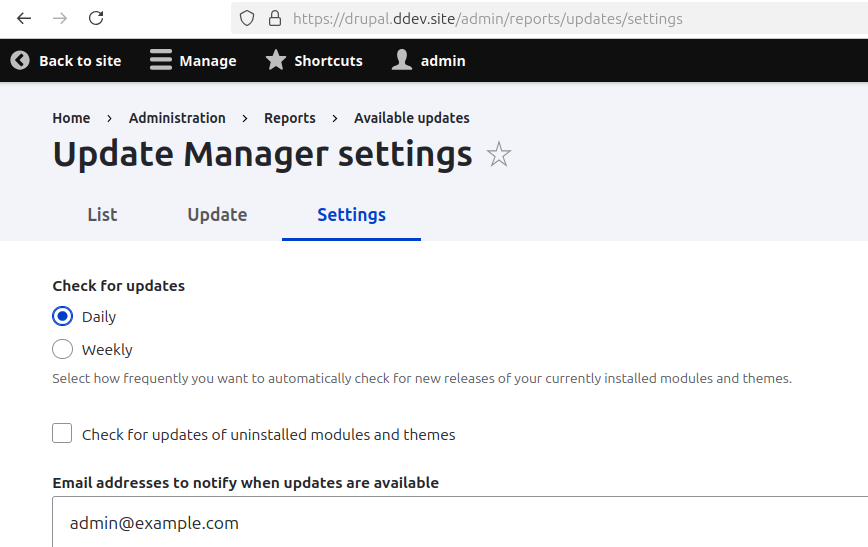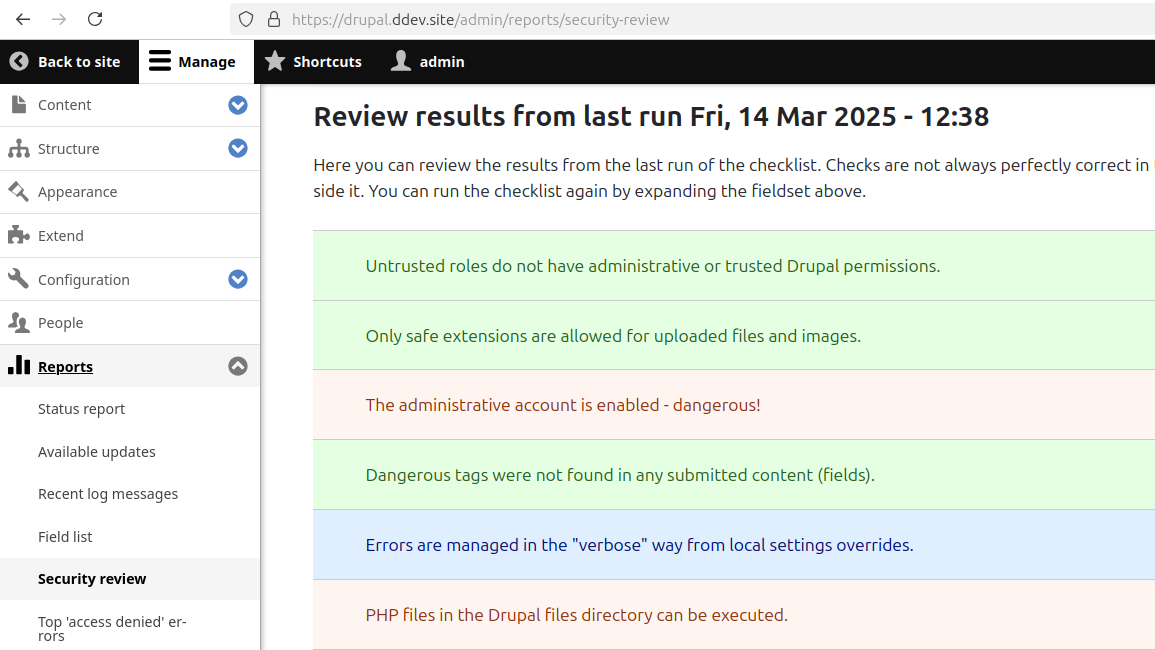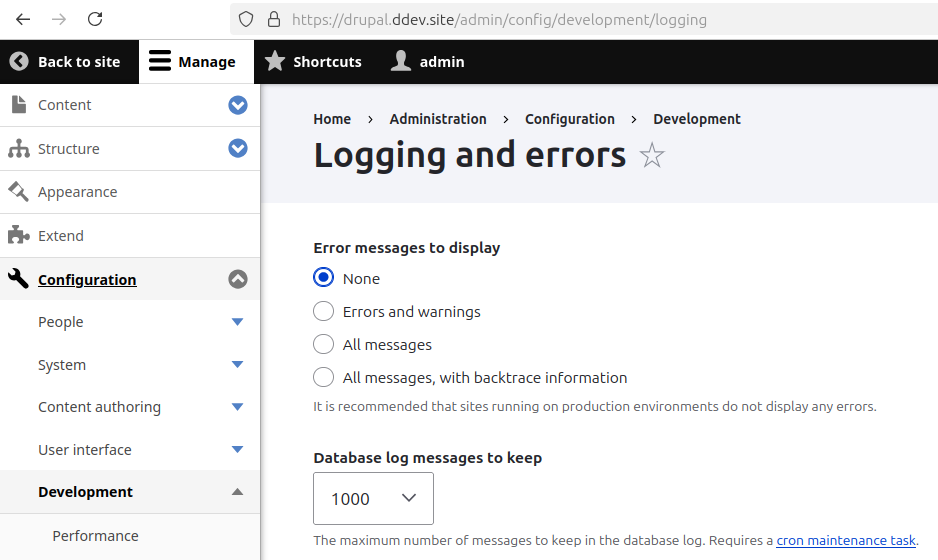Security in Drupal: what can go wrong?
Benji Fisher
March 14, 2025 - DrupalCamp NJ
Introduction
About me

- Benji Fisher
- @benjifisher on d.o
- @benjifisher on GitHub
- @benjifisher on GitLab
Usability group, Migration subsystem, Security team
Follow along

- https://slides.benjifisher.info/ (GitLab Pages)
Outline
- Introduction
- What is the OWASP Top Ten?
- What is Drupal?
- A01:2021 – Broken Access Control
- A02:2021 – Cryptographic Failures
- A03:2021 – Injection
- A04:2021 – Insecure Design
- A05:2021 – Security Misconfiguration
- …
Outline (continued)
- …
- A06:2021 – Vulnerable and Outdated Components
- A07:2021 – Identification and Authentication Failures
- A08:2021 – Software and Data Integrity Failures
- A09:2021 – Security Logging and Monitoring Failures
- A10:2021 – Server-Side Request Forgery
- Conclusion
Attribution
These slides borrow from some of Peter Wolanin’s “Cracking Drupal” presentations and from https://owasp.org/. According to the standard footer,
Unless otherwise specified, all content on the site is Creative Commons Attribution-ShareAlike v4.0 and provided without warranty of service or accuracy.
All of my slide decks have a similar license.
What is the OWASP Top Ten?
Open Web Application Security Project® (OWASP)
The Open Web Application Security Project® (OWASP) is a nonprofit foundation that works to improve the security of software.
source: https://owasp.org/
OWASP is not Drupal-specific. Let’s “get off the island”!
OWASP Top Ten
The OWASP Top 10 is a standard awareness document for developers and web application security. It represents a broad consensus about the most critical security risks to web applications.
source: https://owasp.org/www-project-top-ten/
The list is updated every few years: 2017, 2021, 2025 (planned).
What is Drupal?
Drupal: a content management system
Drupal is a web-based content management system (CMS):
Enter data in my forms. I will save it to the database, then generate web pages.
Hacker:
Sounds great. Let’s get started!
Drupal: exploits of a Mom
Hacker:
Then
will become
xkcd 327 (Exploits of a Mom)

source: https://xkcd.com/327/
Drupal: an active, international OSS project
The Drupal community is one of the largest open source communities in the world. We’re more than 1,000,000 passionate developers, designers, trainers, strategists, coordinators, editors, and sponsors working together.
source: https://www.drupal.org/about
Drupal: take security seriously
The security team is an all-volunteer group of individuals who work to improve the security of the Drupal project. Members of the team come from countries across 4 continents … The team was formalized in 2005 with a mailing list and has had 4 team leads in that time period.
source: https://www.drupal.org/drupal-security-team/security-team-members
A01:2021 – Broken Access Control
Types of vulnerability
- Information disclosure
- Edit/Delete by unauthorized user
- Cross-Site Request Forgery (CSRF)
- … and more
Horror stories (custom modules)
One site had custom access control for /user/1/edit. The
access function left off a “not” and granted access to anyone
except User 1.
Q: How to protect yourself?
Custom modules
How do you avoid horror stories?
- Code review
- Automated tests for every custom page/custom access
- Avoid custom code!
If customers knew the true cost of custom code, they would ask for less of it.
Cross-Site Request Forgery (CSRF)
- mysite.com:
<img src="https://example.com/node/123/delete"> - admin for example.com visits mysite.com
Questions:
- Why does this attack not work?
- What incorrect assumptions expose a similar vulnerability?
How to avoid CSRF
- Use confirmation forms.
- Expect users to tweak URLs:
.../edit,.../delete, and more. - Do not assume form requests come from the form you created.
- Use CSRF tokens: CSRF access checking
- Remember: forms are hard! Web CMS is a terrible idea.
CSRF in Drupal
- Project: Drupal core
- Date: 2021-September-15
- Security risk: Moderately critical 10∕25 AC:Basic/A:User/CI:None/II:Some/E:Theoretical/TD:Default
- Vulnerability: Cross Site Request Forgery
- CVE IDs: CVE-2020-13673
SA-CORE-2021-006 (continued)
The Drupal core Media module allows embedding internal and external media in content fields. In certain circumstances, the filter could allow an unprivileged user to inject HTML into a page when it is accessed by a trusted user with permission to embed media. In some cases, this could lead to cross-site scripting.
SA-CORE-2021-006 (fix)
Solution: upgrade to Drupal 9.2.6, 9.1.13, or 8.9.19.
Commit b230624e5b:
- When editing a WYSIWYG field with a Media embed, add a CSRF token to the header of the jQuery request.
- Validate the token in the code that responds to that request.
A02:2021 – Cryptographic Failures
Cryptography: what goes wrong?
- data transmitted in clear text
- old or weak cryptographic algorithms or protocols
- encryption not enforced
- deprecated hash functions such as MD5 or SHA1
Keep it simple
Unless you are a cryptography maven, do not try to do it yourself. Know when to call for an expert!
Q: What data need protection?
What to protect?
- Passwords
- API keys
- Personally identifiable information (PII)
- Business secrets
PII includes Social Security numbers, credit cards, health information.
HTTP and HTTPS
- Do not manage your own servers unless that is your business.
- HTTPS provides encryption and authentication.
- Enforce HTTPS: Strict-Transport-Security header (HSTS).
- CDN (Cloudflare, Fastly, …)
- Server
- Security Kit module
- SSL is insecure. Use TLS 1.2+
SSL Labs
For example, drupal.org SSL Labs report

Drupal update information
… not to be confused with Automatic Updates/Project Browser initiative
In Drupal\update\UpdateFetcher:
/**
* URL to check for updates, if a given project doesn't define its own.
*/
const UPDATE_DEFAULT_URL = 'http://updates.drupal.org/release-history';We did not fix that until Issue #1538118 2020-11-05. Drupal 7 was fixed 2023-06-06.
API keys
- Use API keys for external services: SMTP, translation, …
- Like long passwords
- Do not commit to your repository.
- If you do, look up BFG Git (Big Friendly Giant).
- Securing
Authentication Credentials in the “Security in Drupal” guide
- Use environment variables.
- Add
settings.phpvalue from external file. - Use contributed modules for key management.
Passwords in Drupal
- User management is one of Drupal’s strengths. Do not “roll your own”.
- Rule #1 (of many): do not store passwords in the database (nor the
file system).
- Store hashed (or encrypted) passwords.
- Rule #2: Make it secure even with the hashed passwords.
- Add “salt” before hashing.
- Use an expensive hash function.
Passwords in Drupal 10.0
In core.services.yml:
# The argument to the hashing service defined in services.yml,
# to the constructor of PhpassHashedPassword is the log2
# number of iterations for password stretching.
# @todo increase by 1 every Drupal version in order to
# counteract increases in the speed and power of computers
# available to crack the hashes. The current password hashing
# method was introduced in Drupal 7 with a log2 count of 15.
password:
class: Drupal\Core\Password\PhpassHashedPassword
arguments: [16]Passwords in Drupal 10.1+
In core.services.yml:
- The comment is gone.
- The parameter is gone.
- See Password hashing is changed (change record).
- See Password Compatibility module (docs for core module)
A03:2021 – Injection
Injection: what goes wrong
- User-supplied data is not validated, filtered, or sanitized by the application.
- Dynamic queries … are used directly in the interpreter.
- Hostile data is used within … search parameters to extract additional, sensitive records.
- Hostile data is directly used or concatenated. …
source: A03:2021 - Injection
Injection in Drupal: SA-CORE-2014-005
Drupal 7 includes a database abstraction API to ensure that queries executed against the database are sanitized to prevent SQL injection attacks.
A vulnerability in this API allows an attacker to send specially crafted requests resulting in arbitrary SQL execution. … this can lead to privilege escalation, arbitrary PHP execution, or other attacks.
This … can be exploited by anonymous users.
source: SA-CORE-2014-005
Injection: my response
Because of the severity of the vulnerability and the simplicity of the update, we tested … and updated the site today.
source: my e-mail to boss and site owner (paraphrase)
Injection: the update
Vulnerable code
Fixed code
(comment snipped from both)
Injection: the next step
// Update the query with the new placeholders.
// preg_replace is necessary to ensure the replacement does not affect
// placeholders that start with the same exact text. For example, if the
// query contains the placeholders :foo and :foobar, and :foo has an
// array of values, using str_replace would affect both placeholders,
// but using the following preg_replace would only affect :foo because
// it is followed by a non-word character.
$query = preg_replace(
'#' . $key . '\b#',
implode(', ', array_keys($new_keys)),
$query
);(line breaks added)
A04:2021 – Insecure Design
A05:2021 – Security Misconfiguration
Configuration: what goes wrong
- Missing appropriate security hardening across any part of the application stack …
- Unnecessary features are enabled or installed …
- Default accounts and their passwords are still enabled and unchanged.
- Error handling reveals stack traces …
- The server does not send security headers or directives, or they are not set to secure values.
File execution: SA-CORE-2013-003
Drupal core [adds] a .htaccess file into the files directories that stops execution of PHP scripts on the Apache web server. This protection is only necessary if there is a vulnerability on the site or on a server that allows users to upload malicious files. … This release includes new configuration to prevent PHP execution on several additional common Apache configurations.
source: SA-CORE-2013-003
File execution: the fix
File: sites/default/files/.htaccess (as of Drupal
7.24)
# Existing lines:
Options None
Options +FollowSymLinks
SetHandler Drupal_Security_Do_Not_Remove_See_SA_2006_006
# New lines:
<Files *>
SetHandler Drupal_Security_Do_Not_Remove_See_SA_2013_003
</Files>
<IfModule mod_php5.c>
php_flag engine off
</IfModule>In case you were wondering
File: sites/default/files/.htaccess (as of Drupal
11.1.4)
# Was Options None; Options +FollowSymLinks
Options -Indexes -ExecCGI -Includes -MultiViews
SetHandler Drupal_Security_Do_Not_Remove_See_SA_2006_006
<Files *>
SetHandler Drupal_Security_Do_Not_Remove_See_SA_2013_003
</Files>
# Was mod_php5.c
<IfModule mod_php.c>
php_flag engine off
</IfModule>The rest of the filesystem
▸ vendor/
▾ web/
▸ core/
▸ modules/
▸ profiles/
▾ sites/
▾ default/
▸ files/
▸ themes/
autoload.php
index.php
robots.txt
update.php
composer.json
composer.lockWho has permission to write to each file/directory?
Automatic Updates

Security Review

Back to Basics
What happens with this markup?
Unsafe HTML

Back to Basics: Text Formats
Which users/roles have access to these text formats?
- Full HTML
- Basic HTML
- Restricted HTML
- Plain text
(Standard profile/recipe)
Back to Basics: Permissions
Some permissions are “restricted”.
Warning: Give to trusted roles only; this permission has security implications.
- Administer comment types and settings
- Synchronize configuration
- Export configuration
- Import configuration
- Translate configuration
- Delete any file …
More Restricted Permissions
- Administer text formats and filters
- Configure any layout
- Translate interface text
- Bypass content access control
- Administer content types
- Administer content
- Administer site configuration
- Administer themes
- Administer software updates
- View site reports
- Link to any page …
A Few More Restricted Permissions
- Administer actions
- Administer roles and permissions
- Administer account settings
- Administer users
- Select method for cancelling account
- Administer views
Errors and Stack Traces
Do not show stack traces on production

A06:2021 – Vulnerable and Outdated Components
The best kept secret in web security
The secret:
The most important thing is to do all the boring stuff you already know.
It is a lot like …
Click bait?
How to live a longer, healthier life!
It takes just 4 minutes a day!
Does that seem too good to be true?
Brush your teeth!
- Two minutes, two times a day.
- Best advice you will get today.
- Also floss.
- You really will live a longer, healthier life.
Web security hygiene
- Use good passwords. Have a policy.
- Keep your software up to date.
- Unless hosting is your core business, do not run your own servers.
Drupal: know the schedule
- Security release windows: Wednesdays 12-5 ET
- Drupal core updates (patch versions): third Wednesdays
- Drupal core updates (minor versions): June and December
- Minor versions are supported for one year.
Drupal: know the channels
- Web: Security advisories
- RSS: https://drupal.org/security/rss.xml, https://drupal.org/security/contrib/rss.xml, https://drupal.org/security/psa/rss.xml
- Email: https://www.drupal.org/user (Edit > My newsletters)
- Slack:
#security-teamchannel in Drupal Slack
Unofficial: @drupalsecurity on X, Mastodon
Drupal: know the difference
- Major version (Drupal 10 to Drupal 11): disruptive
- Minor version (10.2 to 10.3): less disruptive, new features
- Patch version (10.2.3 to 10.2.4): should not be disruptive, bug fixes
- Security release (10.2.9 to 10.2.10): not disruptive (best effort)
Drupal: trust the security team
Two choices:
- Read the SA, decide whether it impacts your site. If so, update.
- Update your site.
Either way, you are trusting the security team:
- They anticipated all the possible exploits.
- The update is not disruptive.
Drupal and Symfony
Q: Why was Drupal 9 EOL scheduled for Nov. 2023?
A: Drupal 9 used Symfony 4, which was EOL in Nov. 2023.
A07:2021 – Identification and Authentication Failures
A08:2021 – Software and Data Integrity Failures
A09:2021 – Security Logging and Monitoring Failures
A10:2021 – Server-Side Request Forgery
SSRF: what goes wrong
SSRF flaws occur whenever a web application is fetching a remote resource without validating the user-supplied URL. It allows an attacker to coerce the application to send a crafted request to an unexpected destination, even when protected by a firewall, VPN, or another type of network access control list (ACL).
SSRF: sort of like phishing
+--------+ +--------------+
| Web | | All your |
Browser -----> | Server | -----> | base are |
| (PHP) | | belong to us |
+--------+ +--------------+SSRF: circle of trust
+======================+
" +--------+ "
" | Web | --> SQL "
Browser -----> | Server | --> Solr "
" | (PHP) | --> Cache "
" +--------+ "
+======================+SSRF in Drupal: SA-CONTRIB-2023-015
The File Chooser Field allows users to upload files using 3rd party plugins such as Google Drive and Dropbox.
This module fails to validate user input sufficiently which could under certain circumstances lead to a Server Side Request Forgery (SSRF) vulnerability leading to Information Disclosure. In uncommon configurations and scenarios, it might lead to Remote Code Execution.
source: SA-CONTRIB-2023-015
SSRF: SA Details
- Project: File Chooser Field
- Date: 2023-May-17
- Security risk: Moderately critical 14 ∕ 25 AC:Basic/A:User/CI:Some/II:None/E:Exploit/TD:All
- Vulnerability: Server Side Request Forgery, Information Disclosure
- Affected versions: <1.13
SSRF: the update (part 1)
Vulnerable code
// file: plugins/Dropbox.php.
public function download($destination, $url) {
return system_retrieve_file($url, $destination);
}Fixed code
SSRF: the update (part 2)
Vulnerable code
// file: file_chooser_field.field.inc.
[$phpClassName, $remote_file] = explode("::::", $file_url);
$local_file = file_chooser_field_plugin_method(...);
// ..Fixed code
Conclusion
Summary
- Introduction
- What is the OWASP Top Ten?
- What is Drupal?
- A01:2021 – Broken Access Control
- A02:2021 – Cryptographic Failures
- A03:2021 – Injection
- A04:2021 – Insecure Design
- A05:2021 – Security Misconfiguration
- …
Summary (continued)
- …
- A06:2021 – Vulnerable and Outdated Components
- A07:2021 – Identification and Authentication Failures
- A08:2021 – Software and Data Integrity Failures
- A09:2021 – Security Logging and Monitoring Failures
- A10:2021 – Server-Side Request Forgery
- Conclusion
References
Contrib modules
- Security Review: Check your site for misconfiguration
- Paranoia: No
PHP
eval()from the web interface - Security Kit: Content Security Policy, Origin checks against CSRF, XSS
- Two-factor Authentication (TFA): Two-factor authentication for Drupal sites
Thanks
- Peter Wolanin (
@pwolanin) for permission to borrow parts of his presentation. - Dave Long (
@longwave) for suggesting SA-CORE-2013-003 as an example of misconfiguration.
Questions

Copyleft

This slide deck by
Benji
Fisher is licensed under a
Creative
Commons Attribution-ShareAlike 4.0 International License.
Based on a work at
https://gitlab.com/benjifisher/slide-decks.